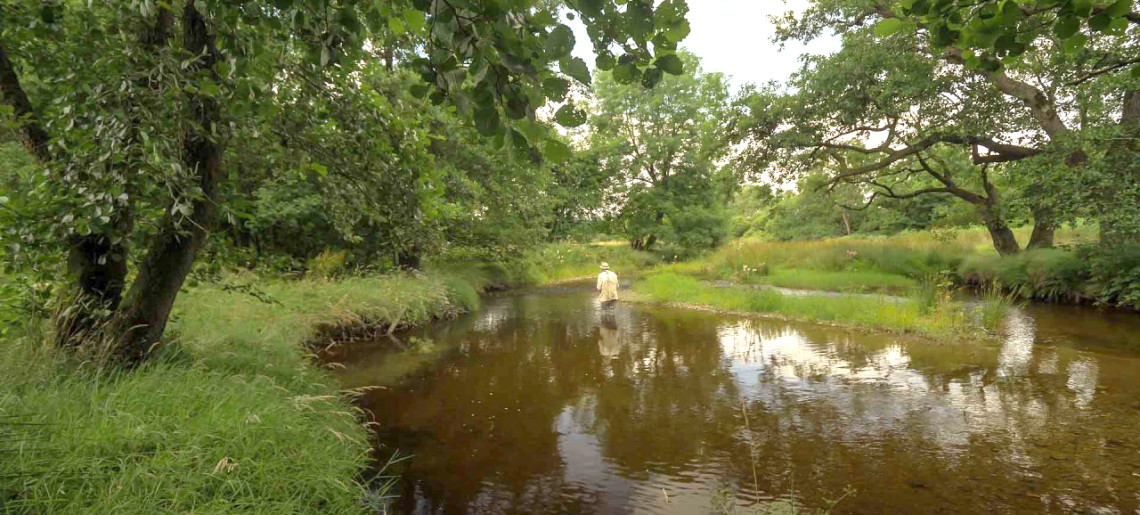We ended July with the rivers at an all-time low. As some kind of compensation for the difficult fishing it was quite an education to walk round familiar beats while mentally mapping the exposed river bed. Where we normally see just indicatory swirls on the surface, now the underlying rocks were exposed to the air like rotten teeth projecting from a jaw bone. You could at least see why fish lie in certain places. At this time the extreme heat of the previous week had left us for a while and in most cases the suspension orders against fishing imposed then had run out. This left the decision as to whether to fish or not in the hands of each prospective angler, ideally armed with a thermometer to check water temperatures. Wyesham fishery recorded a salmon of 12 pounds taken with the fly on the 31st.
 The lower Ithon in August
The lower Ithon in August However, continuing high water temperatures in the Wye below Builth were distinctly worrying. Nor was there any real sign of relief coming. Cloudy days were mixed with the sunny ones, often there was low mist over the hills and sometimes localised showers of rather fine rain. Nevertheless, there was hardly any water flowing down the channels yet, no really serious rain in prospect and, if anything, air temperatures were predicted to rise again over the long term. The short and localised showers were tantalising rather than useful. There were plainly large numbers of salmon and sea trout held up in the estuaries without the water to run further, but it was unclear when the drought would end and we could consider ourselves clear of trouble. Quite unexpectedly on the final day of July heavier showers in Central Wales produced a short-lived rise of about a foot in the upper Wye, the Irfon, and also the Loughor. By 1st August that had translated into a level of 1ft at Llanstephan, a rise of about 9 inches in total, although the water looked quite dirty. (Be in no doubt that when the real flood comes, a huge amount of muck will be washing downstream until the rivers clear). This little rise must have done the Wye some good although the Usk and Monnow were unaffected.
Turning now to fishing reports, AB from Ely fishing the upper Usk at this time had a complaint about the Pantyscallog beat, where the gate to the upstream section is closed off with chicken wire. Landowners fencing in livestock really should pay attention to this sort of obstruction, bearing in mind that anglers are usually wearing fairly expensive and easily damaged waders. We need access without trouser tears and leaks! In similar vein, I will mention concerns about the main access gate (the one with the padlock) at Dinas. The problem here is that the gate is positioned on a very steep gravel track. Anglers either entering or leaving leave their car at a spot just above the gate, with a result that vehicles spinning their drive wheels when starting uphill again are digging a hole. This can be driven around for now but eventually will need filling in, although the problem will recur. As the shepherd who uses the gate daily points out, there will be an accident one day, perhaps a serious one, when a handbrake fails. Judging by recent damage to the gate, a vehicle has already rolled down and crashed into it at some time this spring. My shepherd friend suggests that in the interests of safety, it would be better to move the gate and associated fencing a few yards downhill to flat ground. That’s a decision for the landlord, but for now visiting anglers would do well to stop well short when dealing with the gate, shut down the engine and leave the car in gear. Try to avoid wheel spin on the way back up.
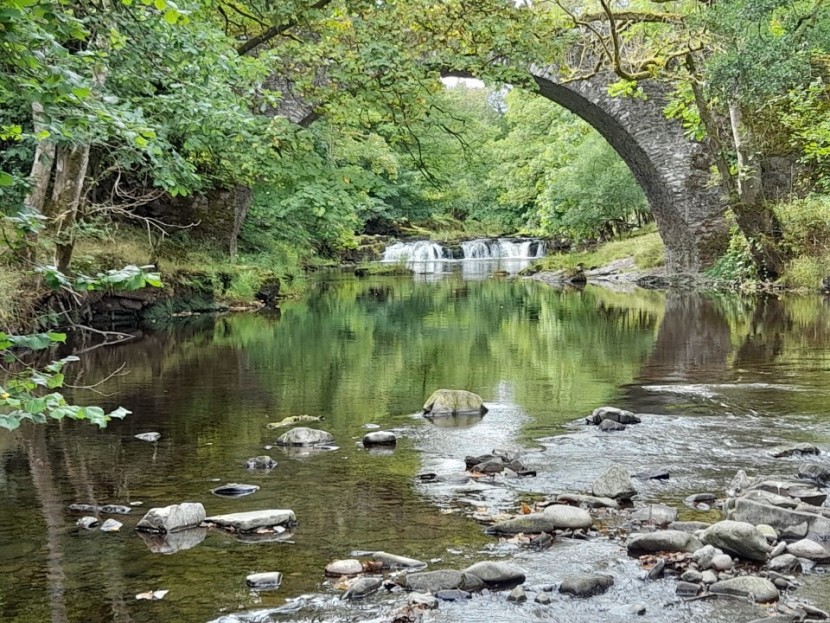 Pantyscallog - AK from Churt
Pantyscallog - AK from Churt 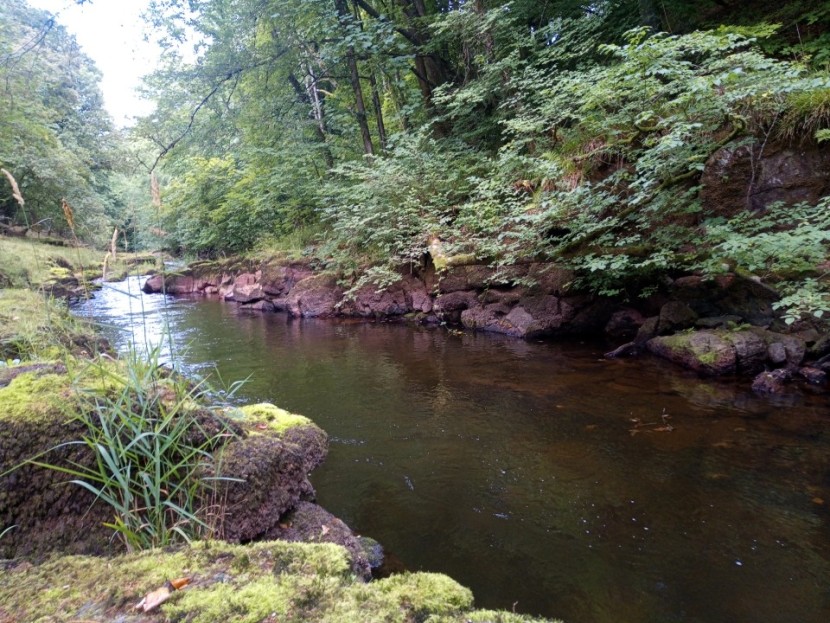 Pantyscallog - DR from Abergavenny
Pantyscallog - DR from Abergavenny  Report illegal fishing
Report illegal fishing Meanwhile JC from Penarth experienced two canoeists paddling the length of the Dinas beat of the Usk while claiming a belief that they were on the canal. Well, it’s August and the silly season, so I expect we can expect some more of that sort of nonsense for a few weeks. KL from Bristol had an interesting time on the Bideford Brook on the 30th despite the very low levels, and caught 19 trout to 12 inches using a nymph under an indicator. That is a very impressive result in these conditions. He mentioned that the beat seems a little more overgrown than in the past. I am afraid he is right about that; it wasn’t possible to carry out the usual pruning last winter, due to the EA concerns about access and crayfish plague in this system, but I plan to get back to it after the end of this season. We have a couple of trees down – always a problem – and it’s amazing how rapidly streams of this size change their bed. LD from Tonbridge fished the Llandysul Angling Association’s water of the Teifi by night and caught 2 sea trout along with 3 brown trout. IR from Northampton was confronted by five youths with spinning rods when he fished the Merthyr Tydfil Angling Alliance water of the Taff. That must have been rather daunting, but still I ask what action was taken or whether any calls were made at the time? I’m reminded of the similar experience of a friend of mine who was fishing the same water in the company of MTAA committee members when the party encountered a poacher. “If you don’t want a 2,000 pounds fine, I should **** off sunshine,” was the spirited greeting used on that occasion, and it seemed to work. Seriously, if you see poaching, call the police or NRW. See the diagram opposite to report all illegal fishing.
Forgive me now if I repeat little gems turned up as I make my way through the reports. It’s a wonderful thing, predictive text, is it not? GW from Reigate with a friend will “…defiantly not be coming back to Sugwas Court” I understand, after a difficult day there, almost as if he feared that further compulsory attendance might be required. Joe Alexander from Leominster was out on the Edw again on the 1st and had 6 trout from the Hergest beat, despite some frisky cattle in the first field. He did take the temperature of the water, found 14 degrees, and so felt his visit was a sensible one. I got the same temperature reading when I measured the Bideford Brook about this time. BD from Aldershot with a friend recorded 8 trout from the Usk reservoir. Another salmon on the fly, a fish of 11 pounds, was reported by the Wyesham beat on the 3rd. The coarse fishing isn’t my particular responsibility, but it was going relatively well and I note that SM from London fishing at Holme Lacey 3 and Lechmere’s Ley recorded no less than 76 chub and 3 barbel on the same day. There were many other big catches of warm water loving cyprinids. And on the 4th August NG from Ystrad Mynach with a friend had an impressive 20 trout from the upper Usk at Cefn Rhosan Fawr.
By the 5th of August, game anglers were again in a quandary. There was still no prediction of rain for the near future and, despite that short-lived lift of a few inches on the upper Wye, the rivers and streams almost everywhere were again low. There was very little good fishing to be found anywhere. What was worse, much higher air temperatures, possibly exceeding 30 degrees again, were predicted over the days to come. At this time some Wye beats were open for fishing; others remained closed by decision of the owners or lessees. The Environmental Agency had reported a couple of algal blooms, but the real risk to fish survival was the water temperature in the main river which was being recorded at from 20 to 23 degrees. The EA had accordingly declared an Amber Alert for the English Wye system and requested anglers not to fish for trout or salmon.
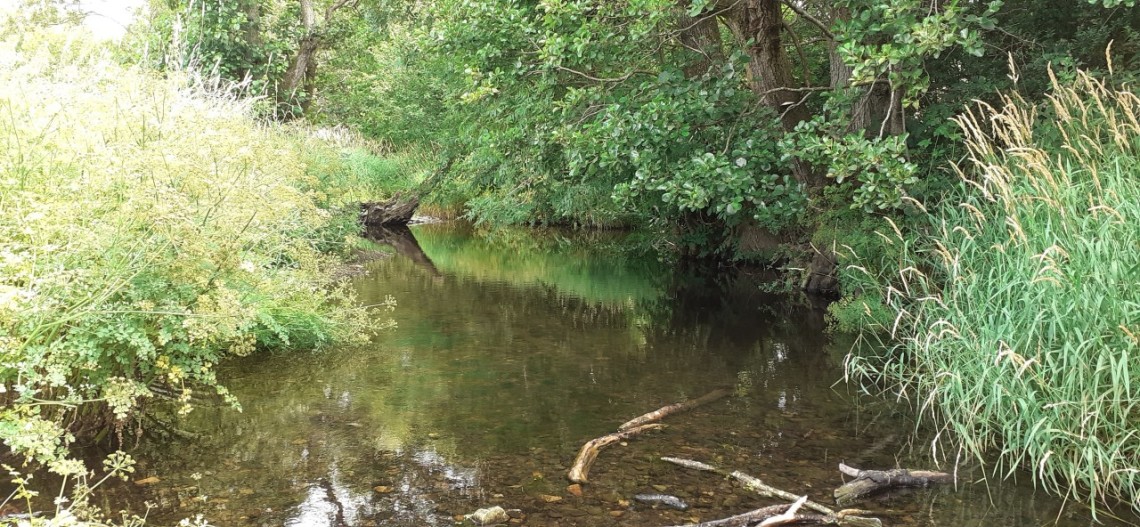 Edwy Hundred House - JA from Leominster
Edwy Hundred House - JA from Leominster  Harvest home already
Harvest home already The heat was gathering again now, without a cloud in the sky. Every morning at home we watched the sun spread across the eastern sky above the estuary in a growing ball of fire. We changed to taking our early morning coffee on the shady side of the house. The landscape everywhere looked parched; hayfields were brown and even the thick woods of the Dean Forest had turned to a uniform dull green. Some of the trees, particularly chestnuts, were already losing their leaves to produce an autumnal appearance. Harvesting was going on apace; farmers having given up on the idea that grains were going to swell any further had decided to get in what they could while conditions remained dry. A national committee for drought had now been formed and due to expected extreme heat a health emergency was declared for the period beginning on 9th August. The problem about this, of course, is that the public are becoming rather used to health emergencies. Even the elderly and most timid are getting exasperated and don’t want to be scared again into spending their time wearing masks and hiding indoors.
Meanwhile water companies, beginning with those in southern England, were announcing hose pipe bans. A discussion of our country’s water strategy, privatised or public, seems always to begin in times like these when the commodity is short, only to be forgotten about as soon as the drought is past. To my great surprise, OFWAT assured everybody that investment by water companies has increased spectacularly since privatisation. I must remark that this seems very hard to understand or believe. What was the money spent on? Employing equality and diversity officers or something else really useful? All I can say is that I haven’t seen many reservoirs built during the privatised period of the last 30 years and not much sign of a coherent strategy. Nor has water become any cheaper. For that matter, those water companies with the highest CEO salaries seem to have the most unacceptable track records of sewage releases into rivers. To put it in the kindest possible manner, as new housing estates are built and new reservoirs and sewage plants are not, our water infrastructure has not kept pace with rapidly increasing population growth. And to share the blame a little by the way, how many of us have traded in our water absorbing lawns and flower beds for concrete car parking pads in recent years?
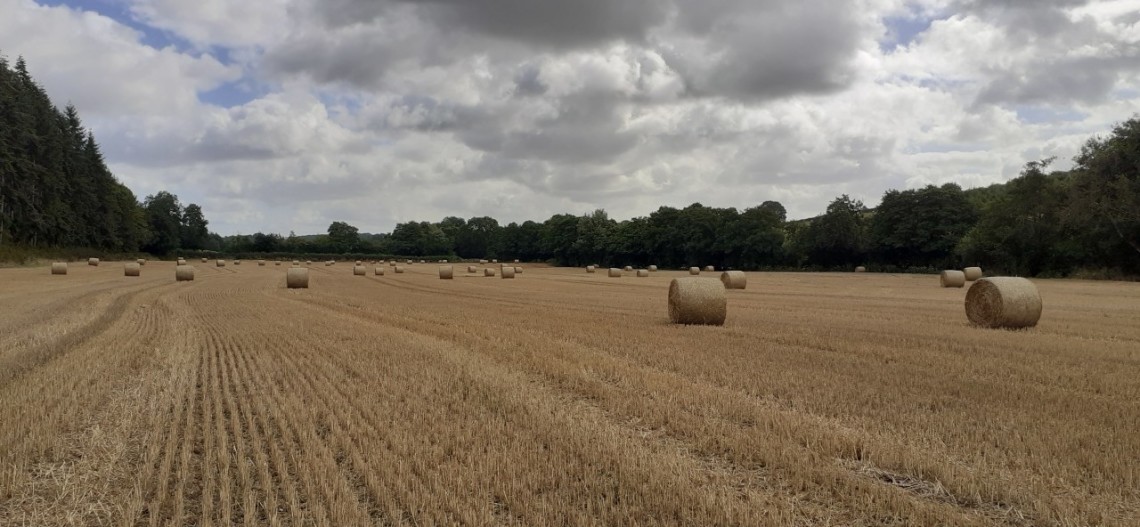 Whittern valley - JA from Leominstrer
Whittern valley - JA from Leominstrer Much attention from the media was paid to the news that the source of the Thames had become became dry. This sort of thing is quite familiar in Hampshire and other chalk stream counties, where the ancient name winterbourne appears so often on the map and refers to a tributary which can be found in the upper part of its valley only during the winter months. I do seem to remember a television programme from those long ago Goon Show days, depicting an expedition which with National Geographic Society support is mounted from Westminster to discover the true source of the Thames. Thus the nation’s three favourite idiots - Michael Bentine, Spike Milligan and Harry Secombe if I remember right - suitably dressed in solar topees, empire-builder shorts and carrying elephant guns, lead a column of bearers fighting their way through the jungles of Henley and Oxford until finally they reach a Gloucestershire field in which a stand-pipe tap is dripping. The Union Jack is planted and the explorers pose for photographs. In a sort of afterthought as the expedition turns and leaves for home, somebody closes the tap. The final scene shows the Houses of Parliament fronted by mud banks and stranded vessels blowing their sirens in a dried-up Thames. Does anybody else remember that, or was it my imagination?
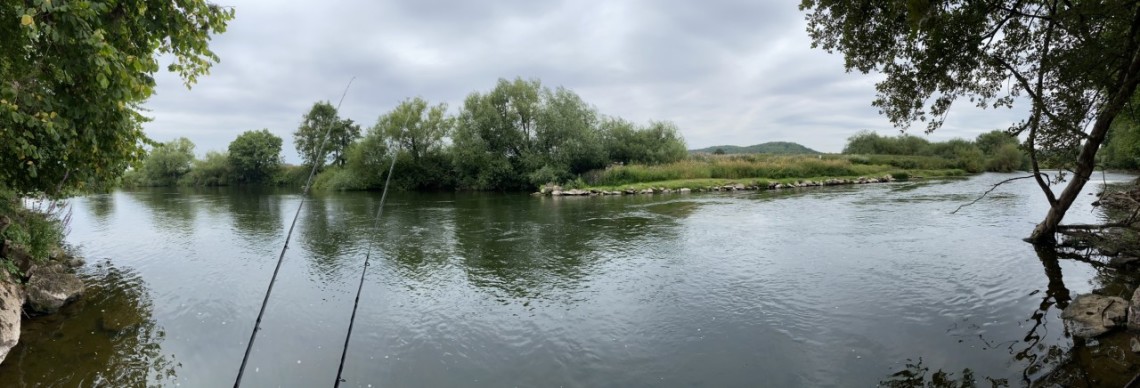 Coarse fishing at Fownhope - JP from Diss
Coarse fishing at Fownhope - JP from Diss Back to fishing and coarse anglers will find the report about Fownhope 5 from MH of the Black Country distinctly interesting. Yet another report of poaching came from JT of London who on the 6th came across 4 people spinning on Talybont Reservoir. What happened at the time please, JT? Meanwhile JK from Aberdare reported 44 trout in the day from Llwyn On. I presume from that we can claim at least one satisfied customer after fishing this reservoir. GM from Shrewsbury accounted for a dozen trout while fishing well up the Wye at Lower Clochfaen. JA from Leominster was unhappy with a fallen tree at the lower end of the Kington beat of the Arrow; there is no way round it. JC from Abergavenny with a friend fished Llangoed and Lower Llanstephan and caught 10 trout and 17 grayling on nymphs. AH from Bromsgrove reported 9 trout taken on dry flies from Llyn Bugeilyn. “Lots of offers,” he told us, which is typical of the Shepherd’s Pool. If you are in doubt on your first trip there, keep moving along the shore and try especially near the lily beds. Hope for a breeze and a ripple. If, on the other hand, you go fishing on one of the currently depleted reservoirs such as Talybont, be very careful as you make your way down the exposed bed towards the water’s edge. A stony exposed ridge can be easy enough, but beware the sheltered hollows in which silt has collected over the years – you could find yourself thigh-deep in clinging mud.
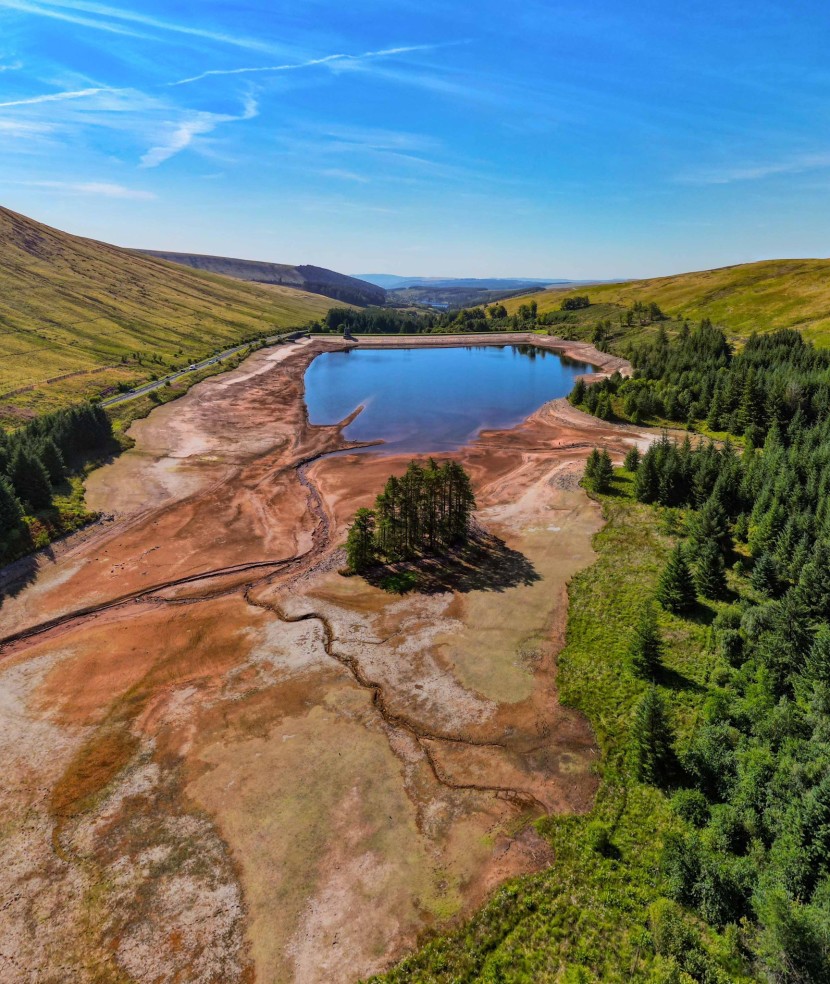 Cantref Reservoir - Robert Melen
Cantref Reservoir - Robert Melen The drought was not confined to Britain. We saw pictures of Spain’s great hydro-electric reservoirs half empty and mass fish kills on the Seine. The Rhine, that great freight highway leading from Switzerland to the Netherlands, was closed to international shipping due to low water levels. A widespread drought in Mexico. And record temperatures in China where tributaries of the Yangtse were running dry.
Locally we found no sign of relief in the forecasts and high temperature readings were being taken from our rivers day after day. On 9th August the Foundation had really no choice but to close the main stems for salmon and trout fishing. This affected the Wye below Builth, eventually the Usk below Brecon, and the fishing suspension was set to last 10 days until 19th August. The matter would be kept under review. Anglers already booked in had the choice of a refund of their ticket fee, or to have the booking switched to a later date. Everybody hoped that two days and nights of heavy rain would go some way to putting everything right, but when would it come? On the evening of the 16th exactly two hours of heavy rain on the lower Wye valley not far from where I live ended as suddenly as it started. A few puddles were left behind on the roads, but there was no detectable effect on local rivers or streams. At least the air temperatures were lower. On 19th August, guided by the latest water temperatures, the Foundation decided to extend the ban on Wye salmon fishing for a few more days.
As might be expected at this holiday time of the year, a fair effort went into fishing for other species. Apart from some large catches of Wye chub, results were quite poor and many of us had just the odd trout or grayling here or there. Lyepole on the Lugg is one beat which held up quite well. On the 13th DA of Woking had 3 trout and 10 grayling on dry flies. On the 21st MS from Stourbridge accounted for 11 grayling. Up on the Raby Estate of the River Tees PM from Cambridge took a dozen trout on dry flies. Two anglers had a good day each at Gromaine and Upper Llanstephan on the 24th. GB from Machynlleth had 4 trout and 8 grayling on nymphs and spiders, while MH from Swansea had 14 trout, 8 grayling and a hefty chub. IS from Merthyr Tydfil had 3 trout from Llwyn On the following day and remarked that the low level actually made the reservoir easier to fish. PR from Caerphilly recorded 11 trout caught on the same day. The WUF came out with new directions on the 25th, as the rivers were still hot and dead salmon were still being picked out of the lower Wye. No fishing for any kind of salmonid was recommended on the Wye below Builth or the Usk below Abergavenny. Anglers should be extra cautious on the Monnow, which was still running close to the danger point. The situation would be reviewed again on 2nd September.
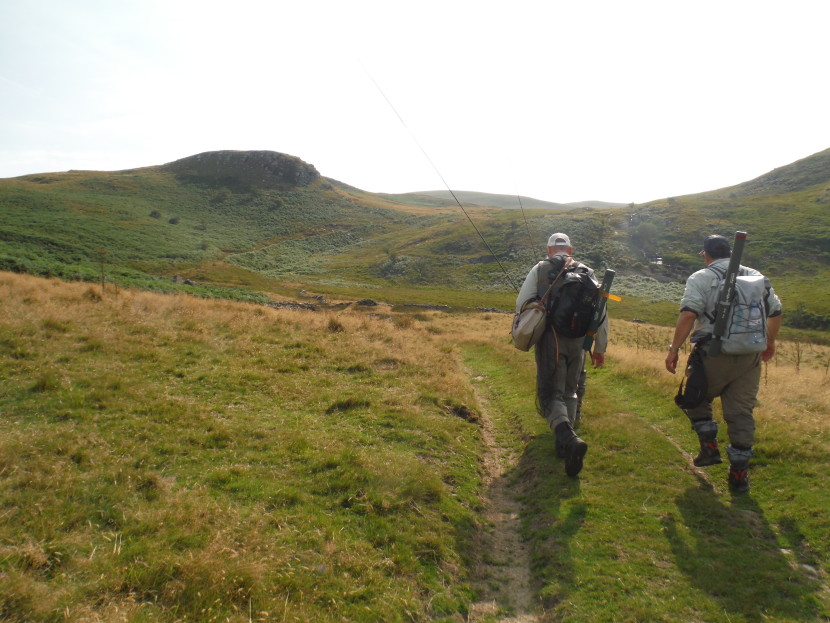 The road to Llyn Gynon
The road to Llyn Gynon 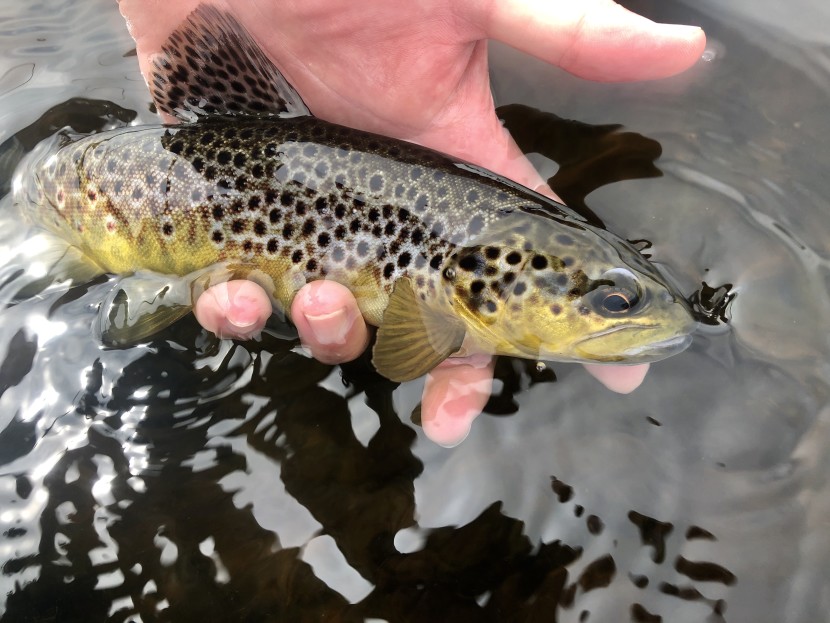 Gynon trout - Lyn Davies
Gynon trout - Lyn Davies Looking to escape lowland heat, Lyn, Rob, Malcolm and I made a raid on Llyn Gynon in the Cambrian Mountains, buying the tickets from Daisy Powell at Rhayader, but then approaching on the next day from the Tregaron side and Strata Florida. As the eldest, I was just about blown out by the 850 foot climb up there, not to mention a slight hangover from the previous very convivial evening in the Talbot Hotel. We dined well at Tregaron. But once we had stumbled through tussock grass to reach the lake in a gentle breeze with clouds drifting close overhead, Lyn insisted on fishing round the whole thing. A sort of caldera high in the hills, Gynon is a natural lake and shallow, which may have accounted for the warmish water temperature on this day. I found it rather dour, although not because fish weren’t taking. I was regularly getting offers to the Kate Maclaren on the dropper, but without really grabbing hold. Eventually I got a few with a Harry Tom on the point. The boys did better, Lyn especially using a pair of little Olive Hoppers drifted round on the wind. Nearly a century ago in his The Lakes of Wales, Frank Ward had this to say about Gynon: “A large and beautiful lake in a setting of moorland and mountain. It lies, remote and solitary, some 10 miles south-west from Rhayader and is rarely visited as it entails a walk of fully three hours from the nearest road, at the top of Dol-y-Mynach. It is reached more easily from the west, as it is not more than 3.5 miles south-east from Strata Florida, with a rough road for 1.5 miles of the distance. This lake swarms with small trout and a good basket may nearly always be secured. A good average here would be ¼ pound, usually it is rather less. There are some larger fish, but they seem to be rarely caught. In fine weather Gynon is a lovely and peaceful scene, although there is a hint of melancholy in its solitude…”
On the 27th AK from Churt reported 5 grayling from the upper Wye at Doldowlod and mentioned seeing what he thought might have been a sea trout weighing about 4 pounds. To be honest, I would find that surprising. Perhaps a big brownie or even a small salmon? NS from Worcester reported 2 trout and a big catch of grayling up to 2 pounds weight taken with nymphs at Craig Llyn. JA from Leominster made several trips to beats on the Edw, catching trout on small parachute dry flies. And at the end of the month VM from Ilkley fished the Tees at High Coniscliffe to take a trout and 5 grayling on nymphs and spiders.
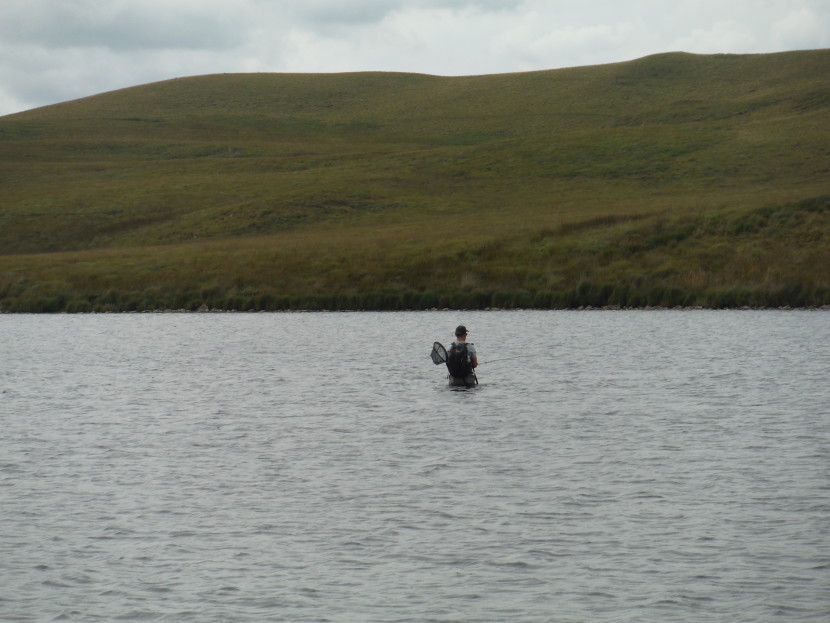 Llyn Gynon - landscape with solitary figure
Llyn Gynon - landscape with solitary figure  Run of the mill Gynon trout
Run of the mill Gynon trout “Hops and turkeys,
Carps and beer,
Came into England,
All in a year.”
Here’s a bit of fun for those who like history or riddles. This might be nonsense, I suppose, but that old ditty has been in my head for ages. I can’t think where it came from. But if there is any truth in it, exactly which happy year would it have been with all those desirable blessings arriving? It makes quite a puzzle to solve.
Leaving the carp aside for a moment, I think it easiest to start with the hops, which must surely be linked to the beer. As I understand the brewing business, you need hops to make bitter beer. Without hops, just brewing with malt and yeast, what you get is ale. This was the regular drink of the mediaeval common folk of England, not very alcoholic and often safer than water at the time. The English were famous over the centuries for drinking gallons of ale, but when they began to add roasted hops, then they began to make and drink beer, or so it seems to me. But did the rhymer/riddler mean the use of imported hops, or hops grown in England? The history section of Wikipedia is helpful here, as usual. There are plenty of mentions of hop-growing in Germany and Holland, going as far back as 736 AD. But Britain, it seems, imported its hops, until a group of Dutch farmers helpfully introduced their cultivation to Kent in 1524. That year, the point at which we could produce our own locally sourced bitter beer, would seem to be a good starting point.
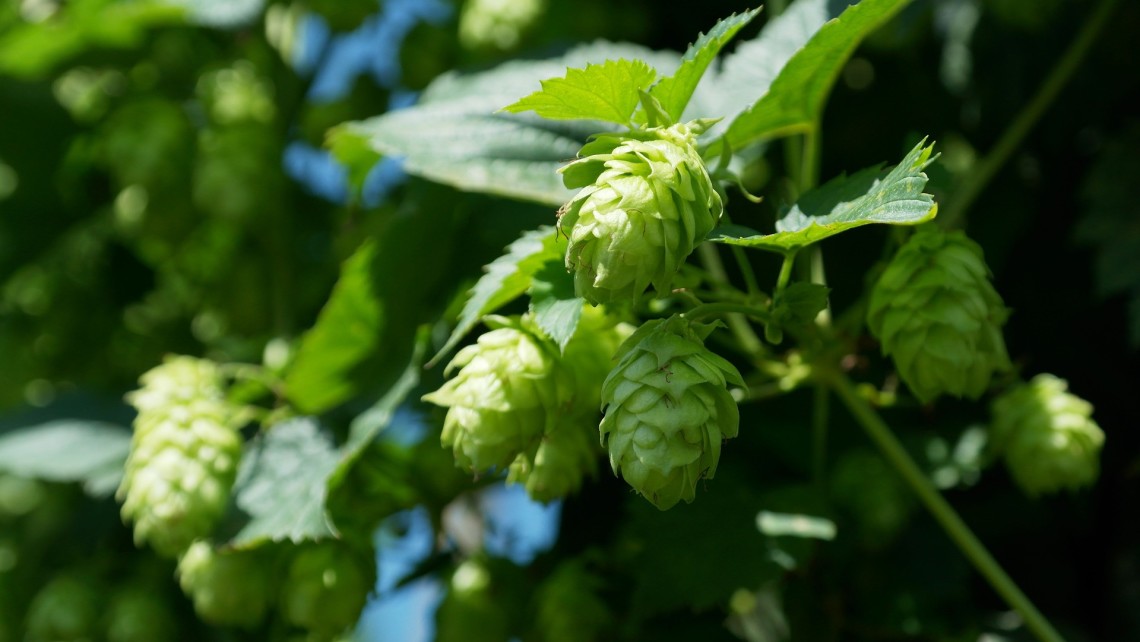
What about turkeys? As everybody knows, this is naturally a New World bird, so I suppose that nobody from the Old World can have seen one until 1492 at the very earliest. Except perhaps a Viking who had undertaken the long row to Vinland centuries before? Before that, wealthy Europeans looking for a good roast would have had to make do with capons, geese or even swans. But can we imagine that somebody on the first Columbus expedition (which didn’t reach the mainland) really managed to bring some turkeys back? Certainly flocks of domesticated turkeys were common in Spain before they were known in other parts of Europe. Alternatively, there is a theory that the bird was imported to Europe via Asia Minor – hence the “turkey-cock” name. Turkeys had definitely reached Britain before the first English colonies were established in Virginia, so we can probably discard the idea that crates of them arrived in London along with tobacco, potatoes and the rest. We do know that in 1550 the English explorer William Strickland was permitted a turkey-cock in his coat of arms, this in gratitude for having introduced the useful bird to his native country. So 1524 or thereabouts also looks like a credible year for the arrival of turkeys in England.
Which leaves the matter of the mysterious carp, for which the evidence about immigration is even less. Our British common carp belongs to a large family, including roach, bream and fancy oriental variations such as goldfish. It doesn’t really belong here in Northern Europe, that much is plain, because it is a warm-water species and, while it is very tough, thrives best in a hotter climate than ours. Let’s deal first with the so-called “king carp.” These with variations such as mirror and leather carp are the ones most commonly angled for today and are really just a domesticated fast-growing version of the original wild fish, and provided by continental breeders over the last century or so. The great carp of Herefordshire’s Redmire Pool, originating from Donald Leney’s young Galician carp supplied in 1932 by Surrey Trout Farms, are the most famous example. I once watched a group of these spawning in the reed-beds of Frensham Little Pond in Surrey. It was a noisy business, rather like a dog fight. Domesticated carp, selectively bred as fast growing food fish, can vary as much as modern breeds of cattle do from the wild originals. For now we can leave these aside. Here I am writing rather about what we call “wild carp,” long and muscular fish, clothed in an armour of regular diamond-shaped scales, glaring with fierce eyes and possessing disdainful mouths with long patrician moustaches. They look like rather like Teutonic knights ready for war and perhaps they should, because their origin is in Eastern Europe. One could imagine them been displaced after the Battle of Tannenburg. For centuries now they may have lived undisturbed in English farm ponds or slower rivers, but we know their natural home is the Danube. I have had the pleasure of fishing for the “old carp” in certain secluded waters and in fact there is one such pool near where I live today. They are extremely powerful fish and have the attribute of speed as well as strength. The first run for cover when hooked is almost unstoppable
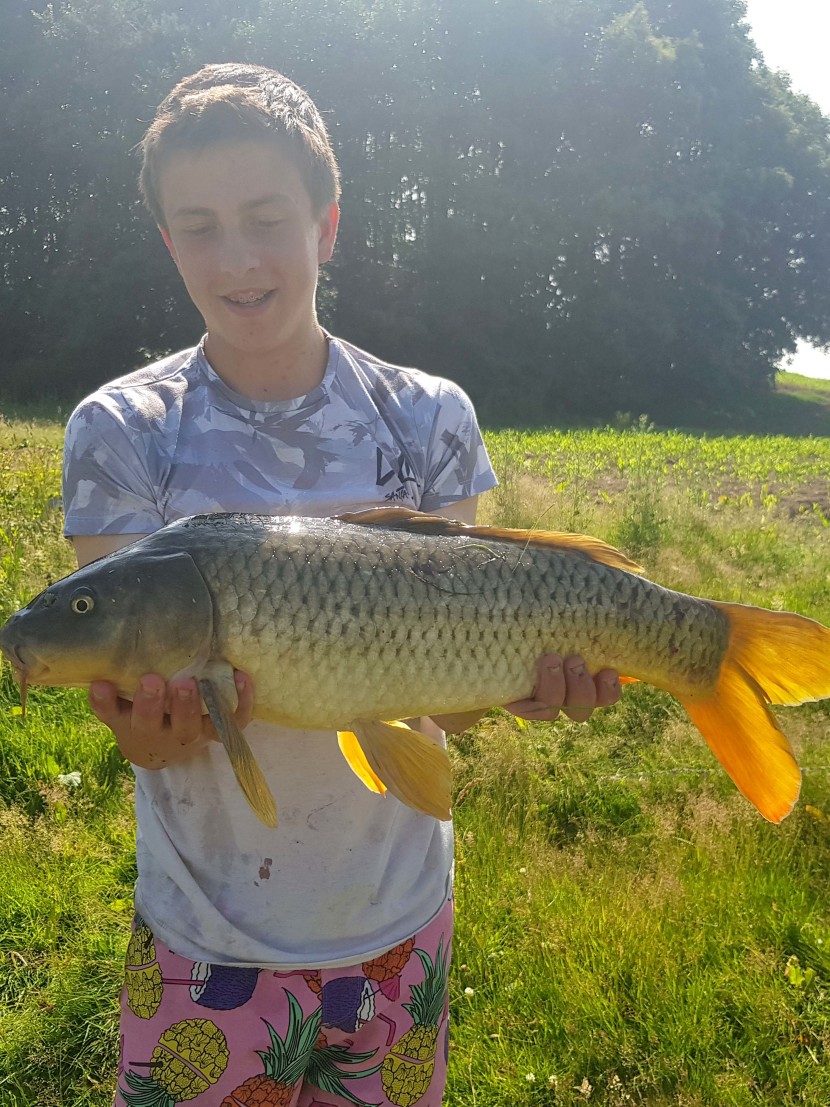
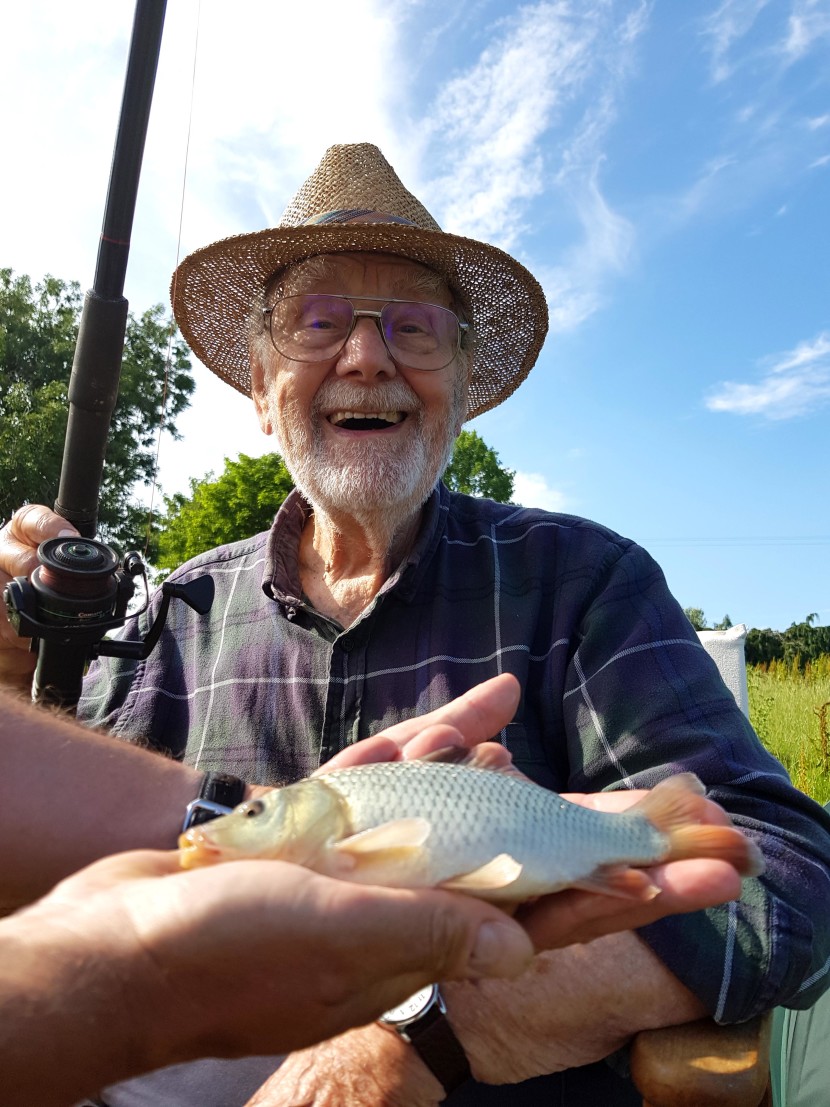
It used to be assumed that carp had been introduced to monastery stew ponds for the sake of Fridays and fast days by mediaeval monks who loved to eat fish. A monastic introduction from the continent is logical enough, but at what date is the question? Do we count the very first carp as an introduction, or should it be the significant establishment of a breeding population? In 1496 the Abbess Dame Juliana Berners (or somebody using her name) wrote in A Treatyse of Fishing with an Angle that of carp at that time there were “…only a few in England.” In 1653 Izaak Walton in The Compleat Angler wrote much about carp, its cunning and how it might be caught. However, he noted also that the species was something new, “….nor hath been long in England” as he put it. We may never find out anything more about this, but 1524 as a date for the definitive establishment of breeding carp in England would not seem to be unreasonable. Carp are now found almost everywhere in these islands, but the introduction to the colder waters of Scotland and Ireland was quite recent.
There is another version of the riddling rhyme, which also includes “heresy” as an import to England in that fateful year. How does the year 1524 fit with the arrival of heresy? Now some people will find heresy wherever they look, but I assume this refers to the reformist teachings of Martin Luther. In 1521 Luther had been outlawed by the Diet of Worms…and how as schoolboys we giggled at the name of that religious conference! By 1524 the Peasants’ War was in full flow on the continent as German monasteries were destroyed and the new protestant states were formed. England was hardly immune from the new ideas and consideration of a rebellion against Rome. From my old house on the hill, when I looked across the Severn estuary to the blue ridge of the Cotswolds, I could see a black stroke breaking the horizon. William Tyndale, whose memorial tower this is, published his translation of the bible into English in 1526 (he was eventually burned at the stake in Belgium for his views and actions). The following year Henry VIII demanded from the Pope the annulment of his first marriage. Anne Boleyn had been at Court and under the King’s eye since 1523. Surely, 1524 was a significant year for England in so many ways!
We had lamb instead of turkey this Christmas last, but I have certainly enjoyed the carp in my time. Most East European countries eat carp and I remember in Hungary a sort of spicy carp stew reddened with paprika. It’s called sharan in the former Yugoslavia and, rather like cod, is often better for some kind of sauce. It’s hard to believe now, but once in Bosnia I was entertained for lunch by the Russian Separate Airborne Brigade, then serving along with NATO members in the international peace keeping force, SFOR. (When I finally left the country, they gave me their blue beret and blue and white striped undershirt as souvenirs. It’s nice to remember a time when Russians and Americans worked together). Smoked carp accompanied by little glasses of vodka was on the menu that day. And I’m still enjoying the beer here in England.
A couple of obituaries seem in order. At the end of July, Ayman al-Zawahiri, international leader of al-Quaeda since Osama bin Laden’s death in 2011, was killed by a missile launched from a US drone while sitting on the roof terrace of his house in central Kabul. It was an extraordinary missile, one designed to kill by its own weight and speed rather than an explosion. Zawahiri, one-time head of al-Quaeda in Bosnia where it was supported by the Saudi High Commission, had an amazingly chequered career and became known as the main architect of the 9/11 attacks on the United States. His former boss, Osama bin Laden, was killed during a US special forces raid on a house and compound right next to Pakistan’s staff college. The sentences above and the location of the two leaders’ deaths, tell you most of what you need to know about the international connections of al-Quaeda. Note that despite the unconvincing explanations of Bush and Blair accompanied by their respective intelligence dossiers, no link has ever been identified between al-Quaeda and Iraq until after the Coalition invasion of 2003. Saddam Hussein and his henchmen in the Ba’ath party were always more interested in whores and whisky than in religious extremist organisations. Al-Quaeda itself is now regarded as old school, a historic collection of aging jihadists. ISIS and al-Shebab are the ones to worry about now.
And the second obituary? We lost Bernard Cribbins last month at the age of 93. Most of us will have memories of a much-loved character actor, from The Railway Children to the Carry On series and Dr Who. Do you remember his hit record, sung in the voice of a cockney workman: Hole in the Ground? But none of the press obituaries which I read mentioned that he was also, by the way, a very good chalk stream dry fly fisherman. That personal interest probably led to his rich accents being used for the voice-over in the Passion for Angling series. For this particular acting job he used a distinctly reverent voice, and this and the glorious photography made Passion for Angling a memorable creation. I wasn’t quite so sure about what appeared to be two adult schoolboys running around in Edwardian clothes with vintage tackle. Off the cuff, Cribbins also once made one of the most perceptive remarks I ever heard about the attraction of fly-fishing. “There is,” he opined, “a reassuring level of difficulty about it.”
The autumn edition of Trout and Salmon includes a wonderful article by David Profumo to mark the centenary of that famous record salmon caught on the Tay’s Glendelvine beat by Georgina Ballantine. The article is full of interesting details about the historic capture and photographs of the beat today. To cap it all, Profumo catches a modest springer (11 pounds) while harling from a boat off the Bargie Stones, just the lie where the monster was found a century before. Thoroughly recommended!
Otherwise, we learned that quite a few records were broken during the last couple of months. Depending on sources, it was the driest July recorded in England for half a century or maybe a whole century. Media journalists were now catastrophizing (a new but very appropriate word) about the cost of living crisis. The Ukrainian war continued, bogged down in artillery battles, with no sign of a resolution. Russia flared off gas rather than export it across the border to Finland. Virtually every political leader in Western Europe talked big during the spring about the salutary effect international sanctions would be having on Russia. Maybe it’s time now to wonder how well we will all stand up to Russian sanctions as the weather gets colder? More Britons than ever before used food banks. And more Britons than ever before flew off on foreign holidays, despite bad service at the airports. Make of that what you will.
Tight lines for September and let’s see those rain clouds roll in!
Oliver Burch
